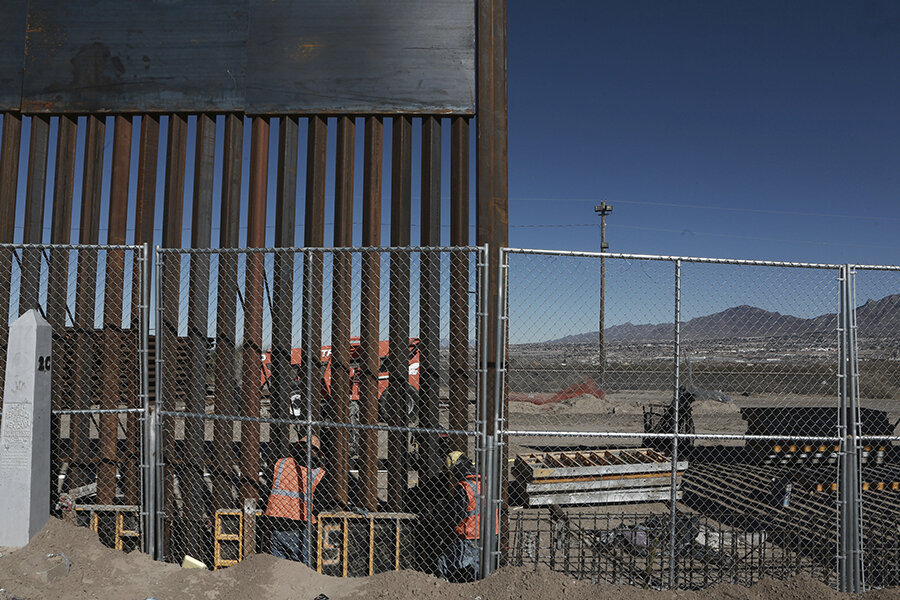With wall, Trump begins reset of America's role since World War II
Loading...
Dubbing it a “big day for national security,” President Trump took steps Wednesday to rein in immigration and harden America’s borders – notably by ordering the “immediate” construction of the wall that was the signature pledge of his campaign.
The executive order begins to cast his “America First” campaign slogan in brick-and-mortar reality.
In doing so, Mr. Trump signaled his intention to pursue the idea that higher walls and stronger borders – not global engagement – best enhances national security. His decision earlier this week to formally withdraw the United States from the 12-nation Trans-Pacific Partnership was further evidence of this general vision.
It marks a fundamental reversal of the national security approach that has defined America in the post-World War II era. Indeed, US global leadership and interconnectedness was not some altruistic gesture, experts say, but rather an essential element of America’s strategy to remain safe and secure. As Trump pulls back from that web of interdependence, it will be a test of how global security – and the US itself – finds a new footing.
“This is a pretty profound change,” says Ryan Crocker, a former US ambassador to Iraq and Afghanistan. The immigration orders signed Wednesday, along with additional executive orders expected to be signed later this week, “will underline this very marked shift in our approach to national security.”
Other orders ahead
Administration officials are hinting that Trump will sign orders this week to temporarily halt refugee resettlement and specifically close the door to refugees from Syria and a half-dozen other countries. The countries under consideration for at least a temporary ban are all majority Muslim. The ban would not be based on religion but on the security risk posed by the presence of Islamist terrorists in those countries.
Banning refugees from the seven countries under consideration – Iraq, Iran, Libya, Somalia, Sudan, Syria, and Yemen – would constitute at least partial fulfillment of Trump’s vow to halt the entry to the US of Muslims.
On one hand, the move would eliminate the chance that a terrorist from those countries could enter the US officially as a refugee. On the other hand, the move plays into terrorist narratives about the US.
Ambassador Crocker was part of a bipartisan group of diplomats and security advisers that advised President Obama against cutting the number of Syrian refugees allowed in the country. The group argued that turning away Muslim refugees would send a message that the West is anti-Muslim.
Trump’s expected order restricting Muslim arrivals, he adds, “is going to confirm to the world that we are anti-Muslim.”
“When we decide to take on the world’s 1.6 billion Muslims, that tells me we are no longer playing the leadership role and living by the values that gave us our preeminence since World War II,” he argues. “With these kinds of actions that cut ties and alienate whole areas of the world, you actually increase the threats against national security, you don’t lessen them.”
At Wednesday’s signing ceremony, Trump took a decidedly different view. He surrounded himself with family members of victims of violence committed by migrants in the country illegally.
“Your children will not have lost their lives for no reason,” Trump told them.
Ever since candidate Trump declared in June 2015 that a lax border was allowing Mexican “rapists” and other criminals to flood into the country, the wall emerged as the touchstone of the campaign. It symbolized a desire to keep out not just individual drug pushers and murderers, but broader threats like globalization and radical Islam.
Mexico as a partner
Regional experts push back against the idea that a go-it-alone strategy is the best path to American prosperity and peace.
“Yes, we want safer borders, but we’ve also learned after a couple of decades of NAFTA that we are better off, we are safer and doing better economically, if Mexico is doing well,” says Luis Ribera, director the Center for North American Studies at Texas A&M University in College Station. “If there are more jobs in Mexico, there will be fewer people crossing the border.”
Agricultural trade, just one slice of the complex commercial relationship between the US and Mexico, has quadrupled since NAFTA came into force in 1994.
Building a wall will not mean starting from scratch. Of the nearly 2,000 miles of border, nearly 700 miles are already fenced or walled off – largely in urban areas and at traditional crossing points.
Earlier wall-building projects caused an uproar among agricultural producers who didn’t want their land cut up by a wall. But Professor Ribera says this time feels different, in part because Trump put his wall in the context of his “America First” campaign.
“To have good trade and relations between the two countries there has to be complementarity – you have to have coordination and collaboration, but that’s not the message we’re hearing from President Trump right now,” Ribera says.
He says he’s seen a “cooling off” in cross-border business relations and investment plans in recent months. “For sure the wall is putting a chill on relations.”








